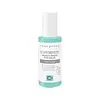What's inside
What's inside
 Key Ingredients
Key Ingredients

 Benefits
Benefits

 Ingredients Side-by-side
Ingredients Side-by-side

Water
Skin ConditioningBetaine
HumectantGlycerin
Humectant1,2-Hexanediol
Skin ConditioningButylene Glycol
HumectantPolyglyceryl-10 Laurate
Skin ConditioningHydrogenated Phosphatidylcholine
EmulsifyingPEG-30 Phytosterol
EmulsifyingPhytosphingosine
Skin ConditioningCeramide Ng
Skin ConditioningIsopentyldiol
HumectantPolyglyceryl-10 Diisostearate
EmulsifyingAloe Barbadensis Leaf Juice
Skin ConditioningDipropylene Glycol
HumectantPanthenol
Skin ConditioningSodium Hyaluronate
HumectantHydrolyzed Hyaluronic Acid
HumectantC12-13 Alkyl Glyceryl Hydrolyzed Hyaluronate
Phenoxyethanol
PreservativeChlorphenesin
AntimicrobialPEG/PPG-17/6 Copolymer
SolventC12-15 Pareth-12
EmulsifyingAcrylates/C10-30 Alkyl Acrylate Crosspolymer
Emulsion StabilisingDisodium EDTA
Sodium Hydroxide
BufferingWater, Betaine, Glycerin, 1,2-Hexanediol, Butylene Glycol, Polyglyceryl-10 Laurate, Hydrogenated Phosphatidylcholine, PEG-30 Phytosterol, Phytosphingosine, Ceramide Ng, Isopentyldiol, Polyglyceryl-10 Diisostearate, Aloe Barbadensis Leaf Juice, Dipropylene Glycol, Panthenol, Sodium Hyaluronate, Hydrolyzed Hyaluronic Acid, C12-13 Alkyl Glyceryl Hydrolyzed Hyaluronate, Phenoxyethanol, Chlorphenesin, PEG/PPG-17/6 Copolymer, C12-15 Pareth-12, Acrylates/C10-30 Alkyl Acrylate Crosspolymer, Disodium EDTA, Sodium Hydroxide
Water
Skin ConditioningGlycerin
HumectantPentaerythrityl Tetraisostearate
EmollientGlycereth-26
HumectantDipropylene Glycol
Humectant1,2-Hexanediol
Skin ConditioningCarbomer
Emulsion StabilisingButylene Glycol
HumectantTrehalose
HumectantTromethamine
BufferingCaprylyl Glycol
EmollientEthylhexylglycerin
Skin ConditioningAmmonium Acryloyldimethyltaurate/Vp Copolymer
Allantoin
Skin ConditioningPentylene Glycol
Skin ConditioningSodium Hyaluronate
HumectantDisodium EDTA
Centella Asiatica Extract
CleansingMadecassoside
AntioxidantGlyceryl Glucoside
HumectantCentella Asiatica Leaf Extract
Skin ConditioningCitrullus Lanatus Fruit Extract
Skin ConditioningAsiaticoside
AntioxidantTocopherol
AntioxidantLens Esculenta Fruit Extract
Skin ConditioningPyrus Malus Fruit Extract
Skin ConditioningSodium Lactate
BufferingSodium PCA
HumectantSodium Benzoate
MaskingPotassium Sorbate
PreservativeWater, Glycerin, Pentaerythrityl Tetraisostearate, Glycereth-26, Dipropylene Glycol, 1,2-Hexanediol, Carbomer, Butylene Glycol, Trehalose, Tromethamine, Caprylyl Glycol, Ethylhexylglycerin, Ammonium Acryloyldimethyltaurate/Vp Copolymer, Allantoin, Pentylene Glycol, Sodium Hyaluronate, Disodium EDTA, Centella Asiatica Extract, Madecassoside, Glyceryl Glucoside, Centella Asiatica Leaf Extract, Citrullus Lanatus Fruit Extract, Asiaticoside, Tocopherol, Lens Esculenta Fruit Extract, Pyrus Malus Fruit Extract, Sodium Lactate, Sodium PCA, Sodium Benzoate, Potassium Sorbate
 Reviews
Reviews

Ingredients Explained
These ingredients are found in both products.
Ingredients higher up in an ingredient list are typically present in a larger amount.
1,2-Hexanediol is a synthetic liquid and another multi-functional powerhouse.
It is a:
- Humectant, drawing moisture into the skin
- Emollient, helping to soften skin
- Solvent, dispersing and stabilizing formulas
- Preservative booster, enhancing the antimicrobial activity of other preservatives
Butylene Glycol (or BG) is used within cosmetic products for a few different reasons:
Overall, Butylene Glycol is a safe and well-rounded ingredient that works well with other ingredients.
Though this ingredient works well with most skin types, some people with sensitive skin may experience a reaction such as allergic rashes, closed comedones, or itchiness.
Learn more about Butylene GlycolDipropylene Glycol is a synthetically created humectant, stabilizer, and solvent.
This ingredient helps:
Dipropylene glycol is technically an alcohol, but it belongs to the glycol family (often considered part of the ‘good’ alcohols). This means it is hydrating and gentle on skin unlike drying solvent alcohols like denatured alcohol.
As a masking agent, Dipropylene Glycol can be used to cover the smell of other ingredients. However, it does not have a scent.
Studies show Dipropylene Glycol is considered safe to use in skincare.
Learn more about Dipropylene GlycolDisodium EDTA plays a role in making products more stable by aiding other preservatives.
It is a chelating agent, meaning it neutralizes metal ions that may be found in a product.
Disodium EDTA is a salt of edetic acid and is found to be safe in cosmetic ingredients.
Learn more about Disodium EDTAGlycerin is already naturally found in your skin. It helps moisturize and protect your skin.
A study from 2016 found glycerin to be more effective as a humectant than AHAs and hyaluronic acid.
As a humectant, it helps the skin stay hydrated by pulling moisture to your skin. The low molecular weight of glycerin allows it to pull moisture into the deeper layers of your skin.
Hydrated skin improves your skin barrier; Your skin barrier helps protect against irritants and bacteria.
Glycerin has also been found to have antimicrobial and antiviral properties. Due to these properties, glycerin is often used in wound and burn treatments.
In cosmetics, glycerin is usually derived from plants such as soybean or palm. However, it can also be sourced from animals, such as tallow or animal fat.
This ingredient is organic, colorless, odorless, and non-toxic.
Glycerin is the name for this ingredient in American English. British English uses Glycerol/Glycerine.
Learn more about GlycerinSodium Hyaluronate is hyaluronic acid's salt form. It is commonly derived from the sodium salt of hyaluronic acid.
Like hyaluronic acid, it is great at holding water and acts as a humectant. This makes it a great skin hydrating ingredient.
Sodium Hyaluronate is naturally occurring in our bodies and is mostly found in eye fluid and joints.
These are some other common types of Hyaluronic Acid:
Learn more about Sodium HyaluronateWater. It's the most common cosmetic ingredient of all. You'll usually see it at the top of ingredient lists, meaning that it makes up the largest part of the product.
So why is it so popular? Water most often acts as a solvent - this means that it helps dissolve other ingredients into the formulation.
You'll also recognize water as that liquid we all need to stay alive. If you see this, drink a glass of water. Stay hydrated!
Learn more about Water